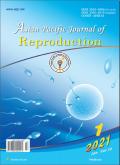Impact of chronological ageing on semen parameters in southern Indian men visiting infertility centre: A retrospective study
IF 0.6
Q4 REPRODUCTIVE BIOLOGY
引用次数: 0
Abstract
Objective: To investigate the association between age and semen parameters among male partners of subfertile couples. Methods: This retrospective study analyzed the semen of 1 523 infertile men aged 26 to 50 years. Data were extracted from GarbhaGudi IVF Centre database from January 2019 to September 2020. The basic semen parameters were interpreted according to the WHO manual 2021, 6th edition. Semen parameters in different age groups were compared. Results: Total and progressive motile sperms were significantly higher in the age group of 26-30 years compared to other age groups (P<0.05). Normal sperm count was significantly higher in the age group of 26-30 years compared to the age groups of 41-45 years and >46 years (P=0.001). However, sperm head defects, neck and midpiece defects, tail defects, and cytoplasmic droplets showed statistically insignificant difference in all the age groups (P>0.05). Semen viscosity showed no statistical difference in all the age groups compared to the reference age group of 26 to 30 years. Conclusions: Higher age can lead to a significant decrease in normal sperms and motility in subfertile men. Hence, male partner age should be considered as one of the major determining factors for reproductive outcomes.时间老化对访问不育中心的印度南部男性精液参数的影响:一项回顾性研究
目的:探讨不孕不育夫妇男性伴侣精液参数与年龄的关系。方法:回顾性分析1 523例26 ~ 50岁不育男性的精液。数据取自GarbhaGudi IVF中心2019年1月至2020年9月的数据库。精液基本参数根据世界卫生组织手册2021年第6版进行解释。比较不同年龄组的精液参数。结果:26-30岁年龄组总精子数和进行性活动精子数明显高于其他年龄组(P46岁,P=0.001)。而精子头部缺陷、颈中段缺陷、尾部缺陷、细胞质液滴在各年龄组间差异均无统计学意义(P < 0.05)。精液黏度各年龄组与参考年龄组26 ~ 30岁比较无统计学差异。结论:年龄增大可导致不育男性正常精子和活力显著下降。因此,男性伴侣年龄应被视为生殖结果的主要决定因素之一。
本文章由计算机程序翻译,如有差异,请以英文原文为准。
求助全文
约1分钟内获得全文
求助全文
来源期刊

Asian Pacific Journal of Reproduction
Veterinary-Veterinary (all)
CiteScore
1.70
自引率
0.00%
发文量
588
审稿时长
9 weeks
期刊介绍:
The journal will cover technical and clinical studies related to health, ethical and social issues in field of Gynecology and Obstetrics. Articles with clinical interest and implications will be given preference.
 求助内容:
求助内容: 应助结果提醒方式:
应助结果提醒方式:


